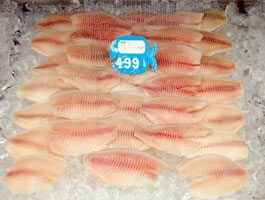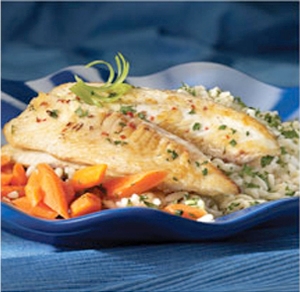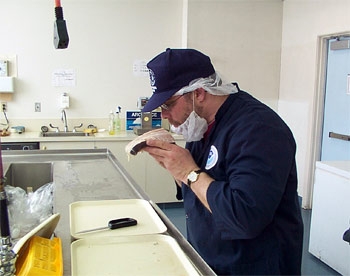Posts Tagged: seafood
Fishing for aquaculture answers
If you buy fresh fish with any regularity you’ve likely come across tilapia. A relative newcomer to American fish markets, the mild, flakey white fish originated in Africa and was introduced to American markets about 10 years ago, sometimes accompanied by favorable sustainability ratings from markets like Whole Foods. Most farmed tilapia consumed in the U.S. currently comes from fish farms in Central America.
“It's a fast-growing fish species that seems more sustainable because it is usually a plant-eater. That is, the fish can survive on plants rather than other fish,” says Alastair Iles, a UC Berkeley assistant professor of environmental science, policy, and management, whose policy research includes studying aquaculture and in particular farmed tilapia.
But sustainability turns out to be a slippery term. “Producing tilapia brings into play a wide range of issues — how developing countries are trying to create sustainable tilapia farming systems but are also struggling with the pollution and waste that they produce,” Iles says.
The scale of the aquaculture industry is expanding around the world, generating, Iles says, a number of environmental and social impacts that cause increasing concern. In addition to the waste problem that fish farms create, feed made from other fish can deplete fisheries even more, and making soy feed may involve land-based agriculture, which could lead to deforestation in countries like Brazil. Escapes of farmed fishes into the wild harm the genetic diversity of the wild tilapia, and there are land use effects as well. As a result, multiple certification schemes are emerging to try to define "sustainable" aquaculture at the global scale.
“It's essential to look at how these schemes are developing because they may affect what the whole industry looks like in the future,” he says.
Iles and his collaborator Elizabeth Havice, an ESPM Ph.D. graduate who is now an assistant professor at the University of North Carolina, are examining two certification schemes that are currently developing: the Global Aquaculture Alliance, the aquaculture industry trade group; and the World Wildlife Fund, working in partnership with the newly formed Aquaculture Stewardship Council.
A new study by the Sustainable Fisheries Partnership, a non-governmental organization, compares the two schemes, and concludes that the WWF certification is tougher in its requirements than the GAA’s standard in that farmers tend to fail the WWF requirements more often. But there is little insight into why and how these differences occur. Is it because the two organizations are using science in different ways — for example, depending on a relatively narrow fish farm-centered impacts analysis, versus using a life-cycle approach that looks at where all the inputs comes from? Or is it because the negotiators of the schemes are aiming at technology-based standards that only large-scale farms can meet?
Iles and Havice focused on the WWF and GGA schemes as most important, examining how they have been developing their standards, which have different requirements. Like the Sustainable Fisheries Partnership study, the researchers are finding that the WWF standard is more likely to be sustainable than the GAA one.
“We think the World Wildlife Fund has paid much more attention to a participatory process and has heard from many more stakeholders, whereas the GAA has been quite top-down,” Iles says. They plan to publish their findings next year.
For now, what’s an environmentally sensitive consumer to do? Avoid farmed fish like tilapia? Iles says that’s not the answer. “We need aquaculture for the foreseeable future because wild-caught fisheries just can't supply enough fish,” he says.
But he stresses that there are very different ways to practice this aquaculture. The new standards, together with Iles’ research to clarify the science behind them, should help navigate the murky waters.
“Our aim is to help improve the science-based process for developing these standards so that aquaculture can evolve into the most genuinely sustainable forms and will actually change how farmers across the world practice their work,” he says.
In the meantime, Iles recommends that if you are buying farmed fish, ask for certification to help ensure that the fish is more sustainable. The new certifications are just beginning to show up in stores, so, watch for them, and demand from your store that they be used.
Is gulf seafood safe to eat?
Fishing has resumed in the Gulf of Mexico, but the Deepwater Horizon/BP oil spill that began in April has dampened consumer appetites for seafood. Consumers have concerns about the effect of the oil spill on gulf seafood, and some are eating less seafood now.
In a June 2010 telephone survey of 1,076 consumers conducted by University of Minnesota’s Food Industry Center, Louisiana State University AgCenter and the National Center for Food Protection and Defense, 89 percent said they are concerned about the spill’s effects on gulf seafood, and 50 percent are “extremely concerned.” When asked about their own eating habits, 54 percent of respondents said the oil spill has affected their seafood consumption somewhat, 44 percent said they will not eat gulf seafood, and 31 percent said they will eat less seafood regardless of its origin.
The gulf produces blue crabs, crawfish, oysters, shrimp and about 86 species of fish including albacore, channel catfish, red snapper and tilapia. Consumers are worried about crude oil and dispersants contaminating the food, but experts say gulf seafood is safe to eat.
“There has been no evidence of tainted seafood entering the marketplace,” says Pamela Tom, California Sea Grant advisor. “Seafood from the gulf has never been as highly inspected as it has been now. Harvest waters are re-opened only after extensive government testing proves that the seafood has not been tainted by oil from the spill.”
The US Food and Drug Administration (FDA), National Oceanographic Atmospheric Administration (NOAA), and the Gulf Coast states cooperate in unison on a protocol to determine when closed federal harvest waters can be re-opened.
Federal inspectors routinely do sensory evaluations or “sniff test,” a rapid method of testing seafood. Highly trained regulatory inspectors can detect oil taint within seconds. More time-consuming, sophisticated chemical analyses of the seafood are also used. Recently, the California Animal Health and Food Safety Laboratory, operated by the UC Davis School of Veterinary Medicine for the State of California, was selected by the FDA to conduct chemical analyses in monitoring seafood from the Gulf of Mexico for toxins related to the oil spill.
To help prevent oil-tainted seafood from reaching consumers during the oil spill, Tom joined a national team to disseminate information on seafood safety steps and monitoring for contaminants in seafood shipments and harvests from unapproved waters. She worked with the FDA, the NOAA Seafood Inspection Program, Louisiana State University and the University of Florida to assemble an oil spill website with resources for gulf fish growers, harvesters, processors and seafood buyers.
So how can consumers tell if seafood is good to eat?
“Buy from reputable dealers,” Tom advises. “Smell it. If seafood smells a little fishy, it could be past its prime, but may still be safe to eat.”
At home, consumers also need to practice sanitation and proper temperature cooking and holding controls. Mixing raw seafood products with cooked product is a formula for disaster, she says. Cooked foods should be kept separate from raw foods, which may have natural bacteria present. Spoilage bacteria compete with pathogenic bacteria, but proper cooking of raw fish at 145 degrees F for 15 seconds destroys the bacteria. If pathogens are re-introduced after the seafood is cooked, under the right conditions pathogenic bacteria can grow and may lead to foodborne illness.
“Some pathogens will grow in your body, while other pathogens may create toxins in food,” Tom says. “Some toxins are heat stable and some are not. Food safety is a very complex situation and some consumers are more susceptible to foodborne illness than others.”
Safe cooking and holding practices at home include placing seafood on ice or in the refrigerator or freezer soon after buying it. The temperature holding range should be below 40 degrees F or above 140 degrees F. Bacteria that can cause foodborne illness can grow quickly at warm temperatures between 40 degrees F and 140 degrees F.
Consumers can find more information about seafood safety and quality at UC's Seafood Network Information Center website.




